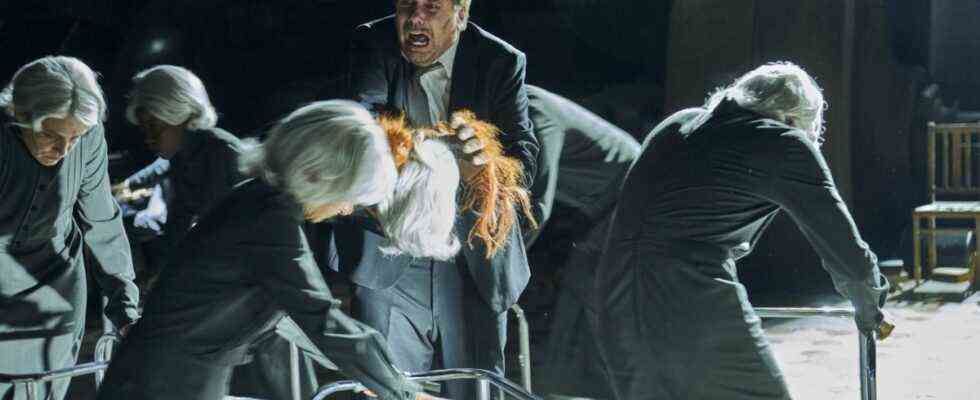If there is one challenge in staging Edgar Allan Poe’s “The Downfall of the House of Usher”, it is the level of horror that remains unchanged. Even when the nameless narrator in Poe’s perhaps most famous short story rides on his horse to the castle of his school friend, everything is gray, sad, oppressive, the sky, the landscape, the shadows. And already in line eight, when looking at the building, the protagonists feel an “unbearably gloomy feeling”. The house, framed by dead trees and a swampy pond, with its dead window eyes, the mushroom growth and the fine zigzag crack in the wall, animates the poor hurrying to help to an epidemic of gruesome adjectives and superlatives, that already after the first paragraph only a small increase from the most sinister to the most gruesome seems possible.
When it comes to theatricalization, the question arises of how to create an arc of suspense. Barbara Frey, the Swiss director, who will direct the Ruhrtriennale for the next three years, decided to forego Klimax entirely for the opening production of their first edition. In the beautiful Zweckel machine hall in Gladbeck, in front of the decommissioned hoisting machine with its eleven differently sized drive wheels, the evening began with harmonious monotony. Two pianists (Tommy Hojsa and Josh Sneesby) hammered the same chord progression synchronously into their grand pianos and transposed them in small steps from the highest to the lowest register.
A chorus of drooping heads marveled in amazement – all evening long
With this penchant for a constant rhythm, Frey then staged the story. A chorus of hanging heads, uniformly dressed in black with a mourning binder, slowly moved from the background of the dark industrial hall to a few scattered instruments and books that made up Martin Zehetgruber’s set, and practiced the common expression of foreboding astonishment. The three women and three men were not supposed to take it off for the whole evening. Whereby the dark story of the mysteriously ill twins Roderick and Madeline and the return of the already buried sister Barbara Frey was not enough as a text basis. She or her dramaturge Andreas Karlaganis searched Poe’s oeuvre for comparable motifs and found useful parallels in four other pieces.
Debbie Korley tells the short story of a fairy on a pond who, while rowing around an island with a light and dark side, falls in increasing grief and dies. Annamária Láng and Markus Scheumann illustrate Madeline’s feeling when she wakes up from her apparent death in the deep crypt of the castle with Poe’s dungeon story from the time of the Spanish Inquisition, “The Pit and the Pendulum”. Michael Maertens, disguised as a monkey, quotes from Poe’s crime story “The Double Murder in the Rue Morgue” a passage in which C. Auguste Dupin argues about the difference between analytical thinking and acumen. And Katharina Lorenz and Jan Bülow refer in musical speech to the story of Poe, in which a sick cousin buries his cousin alive, “Berenice”.
Presumably, staging this collection of fragments as a pathetically stylized slow-motion theater with melancholy music is really a matter of taste. The constant exaggeration of excited feelings that Frey demands from her ensemble, almost in silent film fashion, is artificial and artificial to such an extent that it can easily be perceived as kitsch. On the other hand, in the little happening grouping of people who recite prose texts about paralyzing fear in different constellations, an atmosphere of Edgar Allan Poe is of course adequately captured, which corresponds to his style of writing about unbelievable things. The balanced composition of delusional moods through suggestive music, rigid speaking and expressionistic lighting moods then fulfills its purpose of depicting a situation of constant emotion.
This co-production with the Vienna Burgtheater heralds a six-week festival program that deals a lot with the threat to women and alternatives to the weary lifestyle of the present. In the monuments of industrial culture between Bochum and Duisburg, the horror of man is traced. But its downfall can possibly still be averted despite growing cracks in the building and poisonous ponds in front of the front door. In any case, the Ruhrtriennale takes care of something – also a little hope, joie de vivre and artistic defiance.

